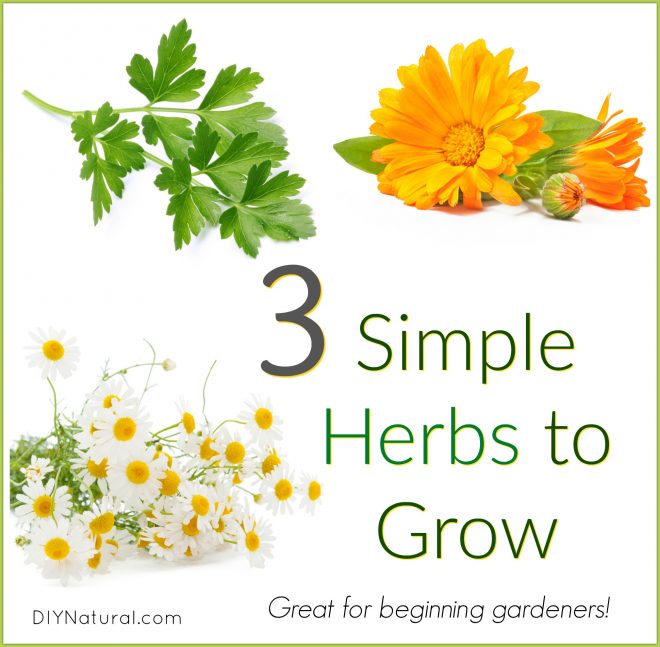
The garden catalogs are all over the living room in our house. They travel with us to bed and into the kitchen for breakfast, but seem to be a permanent carpet in the living room. We’re all dying to get outside and get our hands in the dirt with spring fast approaching. Are you making plans for your gardens yet?
Start with a Few Easy Herbs to Grow
Perhaps this is the year you have decided to dive into an herb garden. If so, I have a few tips for you. Not all herbs are created equal when it comes to ease of planting. For instance, while everyone loves the idea of growing lavender it can be finicky. It seems I get asked at least once every year which variety I have successfully grown here at our farm.
Some herbs take multiple years to germinate from seed, some require a trip through the freezer before planting out, and some like to be soaked overnight before planting out. You can learn all these particulars over years of practice, but when you want to get started I find that it is best to go with herbs that aren’t too finicky and can give you a quick feeling of success.
Growing Parsley & Other Easy Herbs to Grow
Growing Parsley (Petroselinum crispum)
We start these from seed right in the garden after the danger of frost has passed. My mom has managed to keep a pot of parsley going, bringing it in for winter and setting it back outside in the summer, for three years now.
Growing parsley is pretty straight-forward. It isn’t very particular about its soil, likes full sun and appreciates a good watering at least once a week, unless nature does it for you. Parsley can be cut for use and then allowed to re-grow for several more crops throughout the summer. Parsley is very high in Vitamin C and is a boost for the immune system and a tonic for those overstressed adrenal glands. (If you need more convincing of its health benefits, you can check out Benefits of Parsley: Not Just For Garnish Anymore.)
Growing parsley is also simplified because it’s a biennial so it will overwinter in most places and give you leaves for two years. The second year though, it will flower and you can then collect and save the seed to start the process all over again the following spring.
Get organic parsley seeds here and determine where to plant them after the last frost.
Growing Calendula (Calendula officinalis)
We’ve set out plants of calendula and also easily started them from seed after the last frost has passed. If you decide to grow these beautiful flowers from seed you’ll want to put them in full sun and keep them weeded until they are established. Once they get going they grow large enough to take over the weeding job on their own, completely covering the soil with their leaves.
Calendula blooms are important for skin health; I love to infuse them into oil and keep them dried for baths and soaks. For a rash like eczema they are invaluable. The flower petals are edible and make beautiful additions to salads and confections. Internally, the flowers have hormonal balancing properties. Just like any other flower, the more you pick the yellow calendula, the more blooms you will have.
Calendula is an annual in temperate climates. Here in Ohio, it is a pretty successful self-sower. You can find organic calendula seeds here.
Growing Chamomile (Matricaria recutita)
There are two types of chamomile: Roman and German. The German chamomile I am referencing here grows as an annual. In my garden it is a self-seeder so I am never without a thick patch of the sunny, white flower.
Most people know that chamomile is soothing for the nervous system. It is also an important tonic for the digestive system and anti-inflammatory when used topically on the skin and eyes.
Chamomile is really simple to plant. It is a very tiny seed and barely needs to be scratched into the surface of the soil. It sprouts very quickly and makes a nice companion to your brassicas. You can find organic German chamomile seeds here.
Getting started with these easy herbs to grow because it’s easier that you think, and will give you confidence to grow more. Pick a couple easy plants like the ones above to start with. If you’re feeling overwhelmed already, start with seedlings rather than seeds. Once you get the hang of the easy growers you can move on to the plants that have more attitude!
Have you ever grown any of these herbs? Which easy-to-grow herbs are your favorites?
*******




HI
About Parsley I have some ‘tale to tell’. There is a German ‘Kinderreim’ (kid’s poem) that basically says, “Parsley and Celery grow in our garden. Lieschen is the bride. She can’t wait any longer.” (Petersil und Suppenkraut, waechst in unserm Garten. Unser Lieschen ist die Braut. Kann nicht laenger warten.)- meaning she needs to get a groom as she is pregnant. When I started out with my second husband living in a certain place in Namibia I also started a little herb garden and the parsley I tried grew like it was going out of season. It kind of took over my little patch. I was pregnant at that time. The next year nothing would grow. My baby was born. Two years later the parsley again sprouted easily. I was pregnant again. Since then parsley is very reluctant to grow in my gardens. I may just be not pregnant enough. 🙂
This is just to show how ‘folklore’ seems to have it quite right.
Love reading your articles very useful information.I have been growing parsley for a long time ,love using it in salads.g